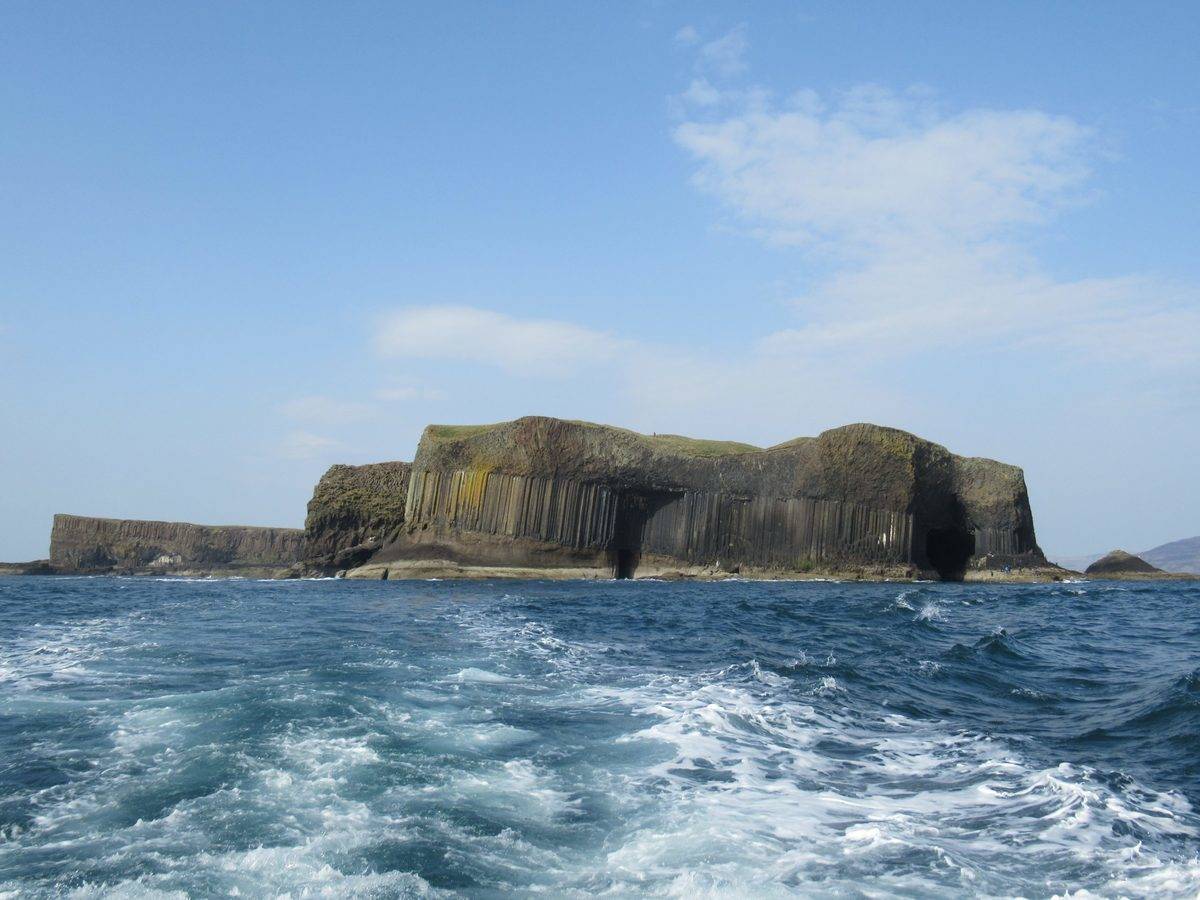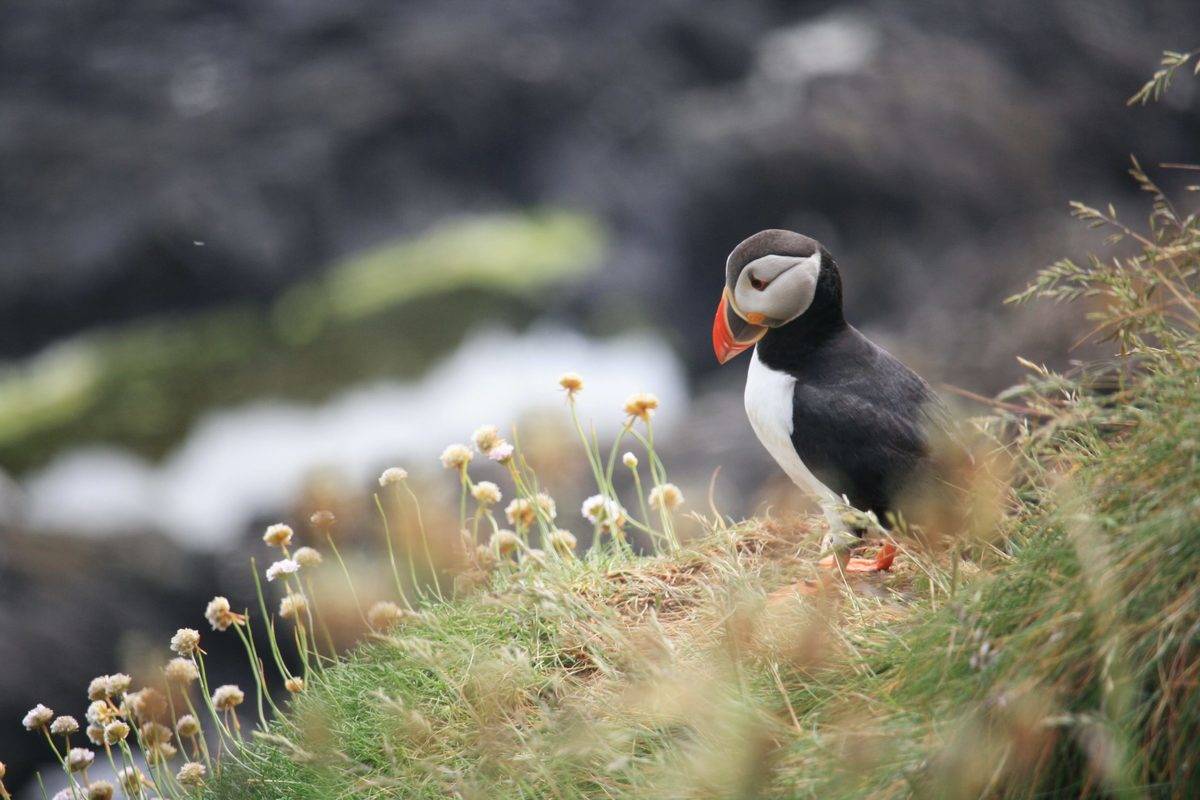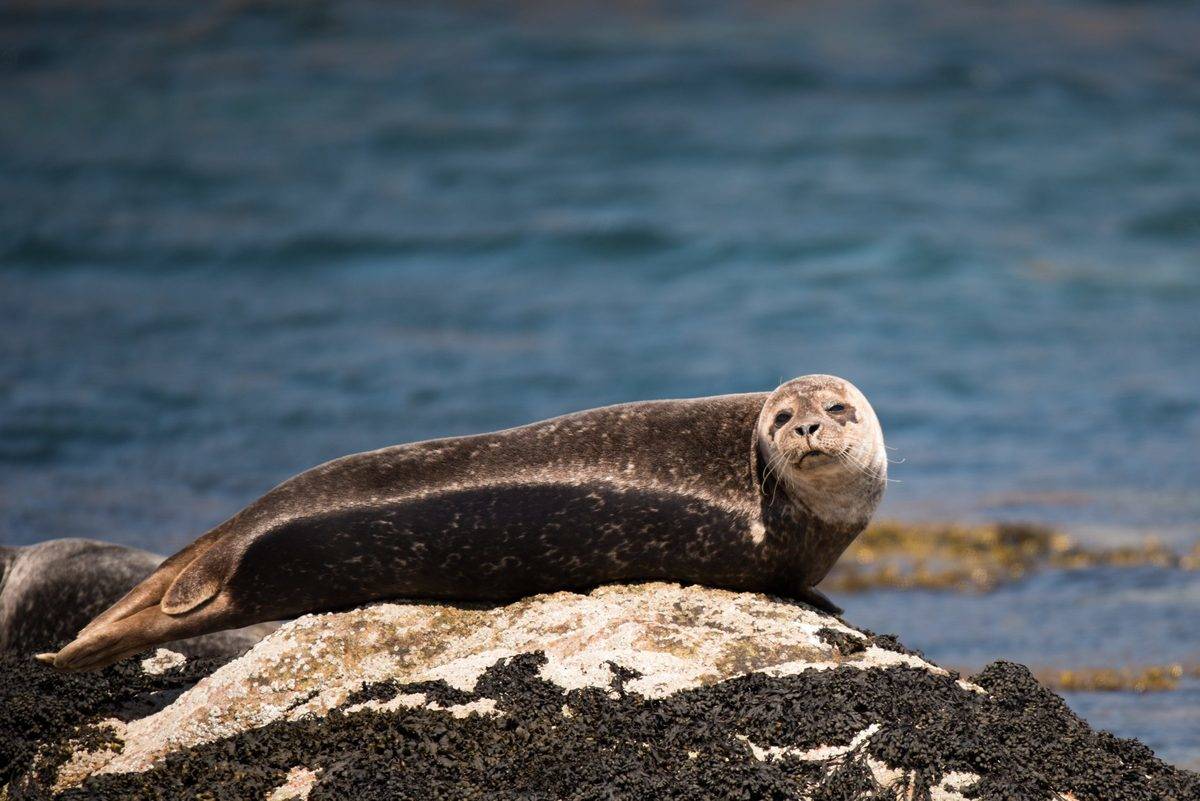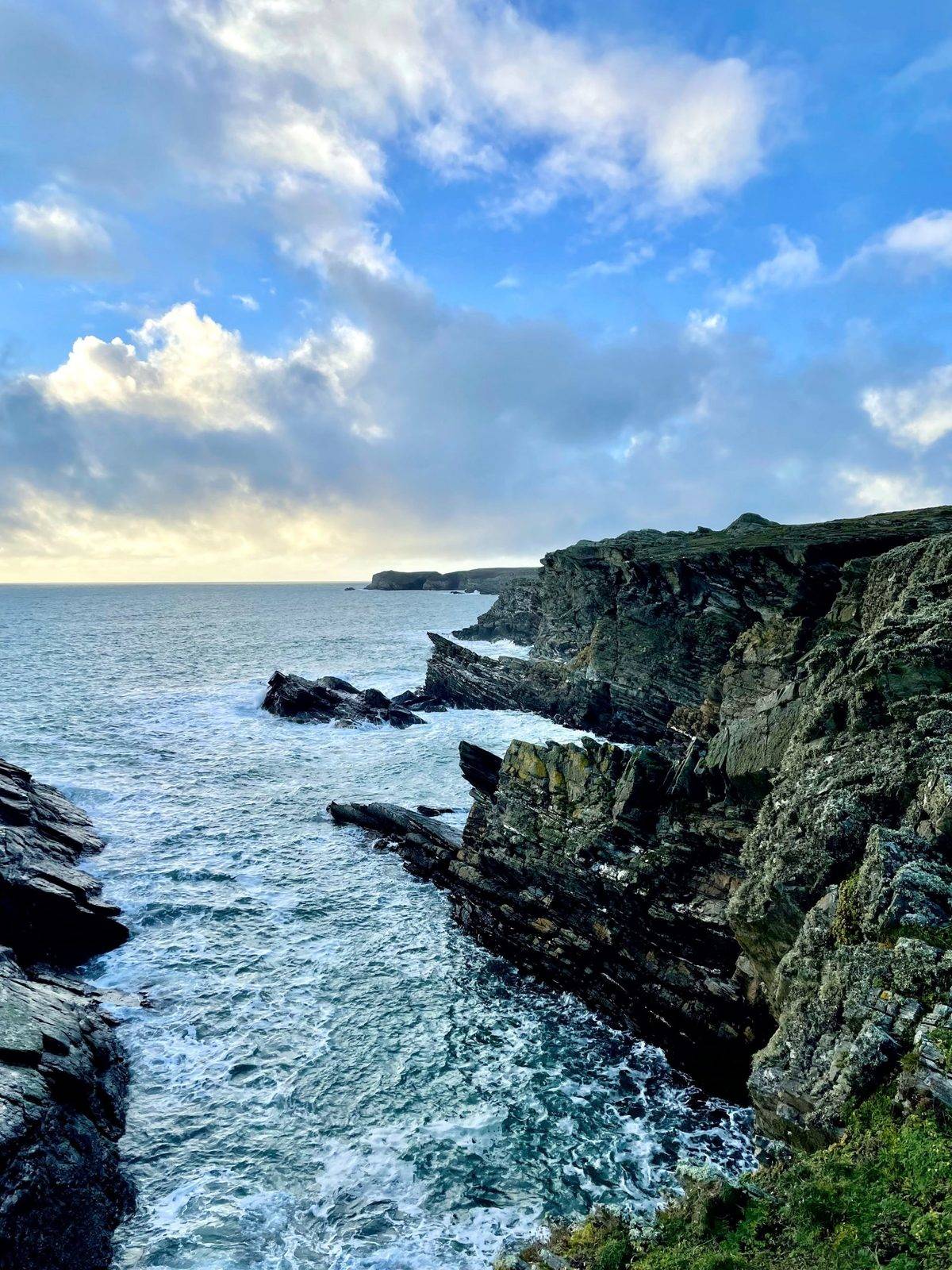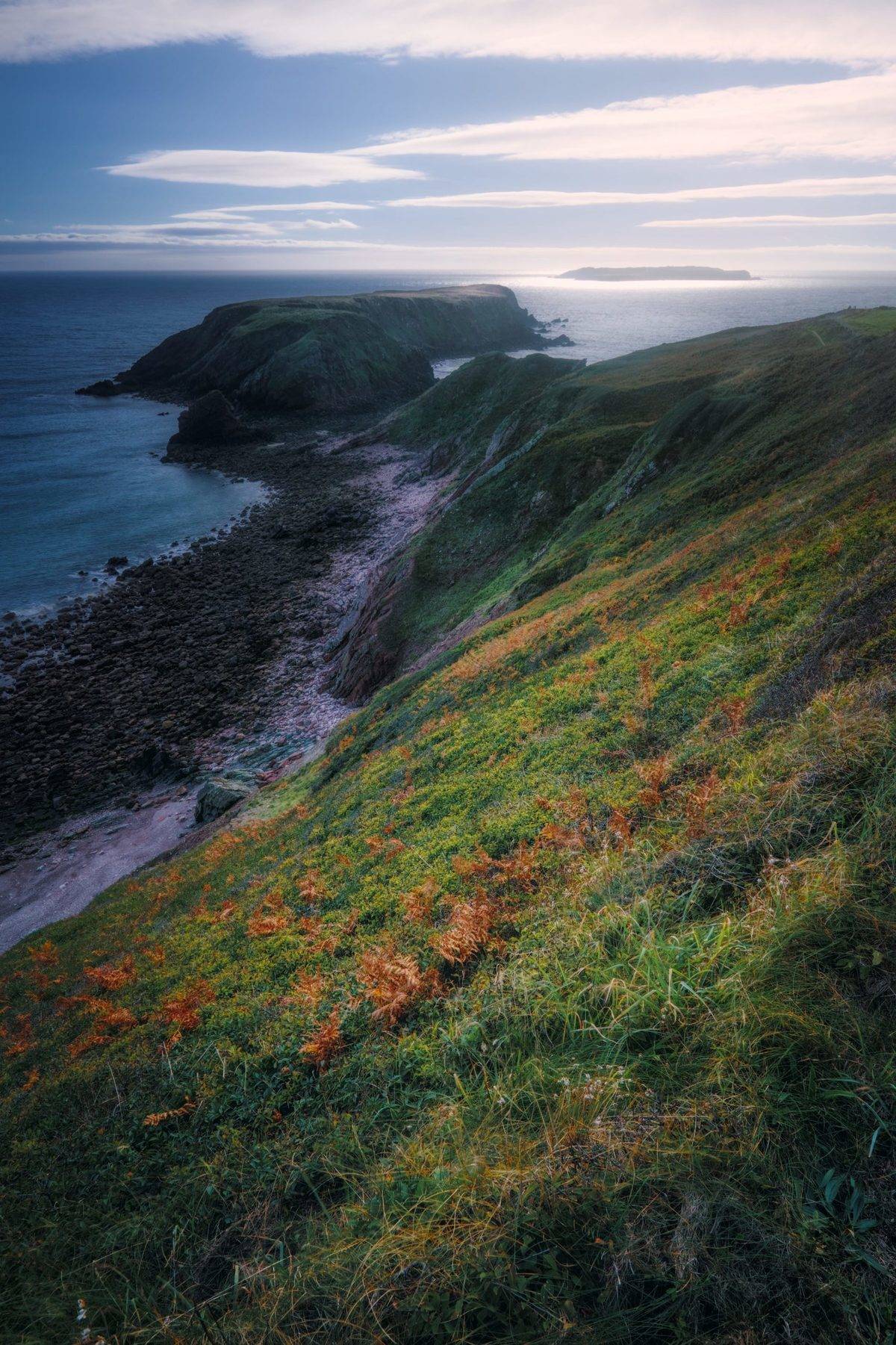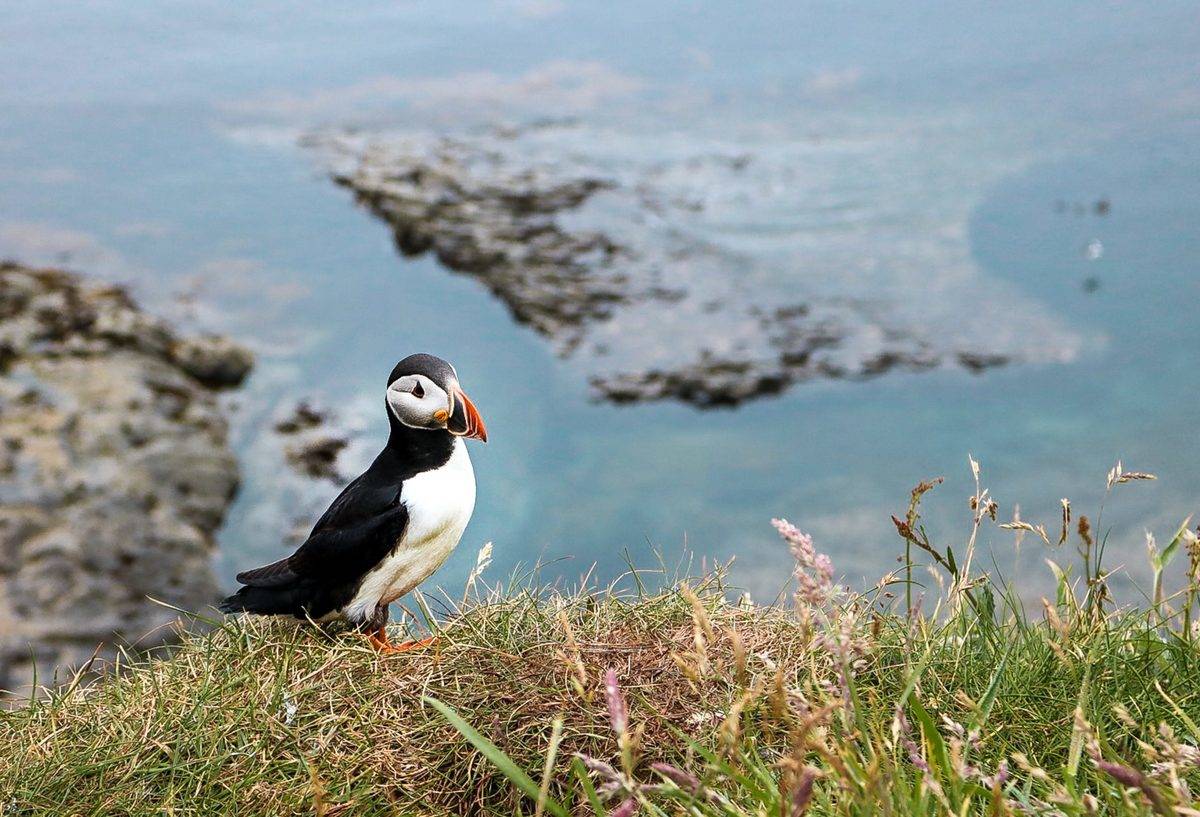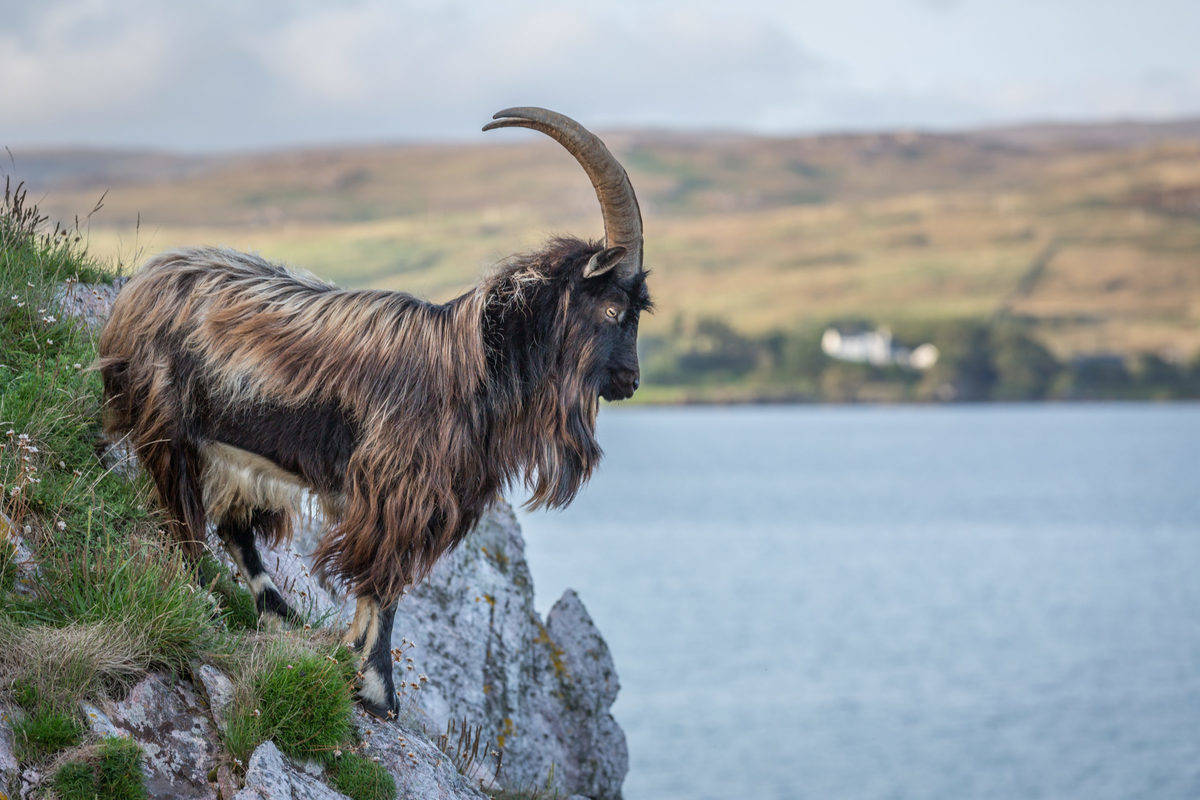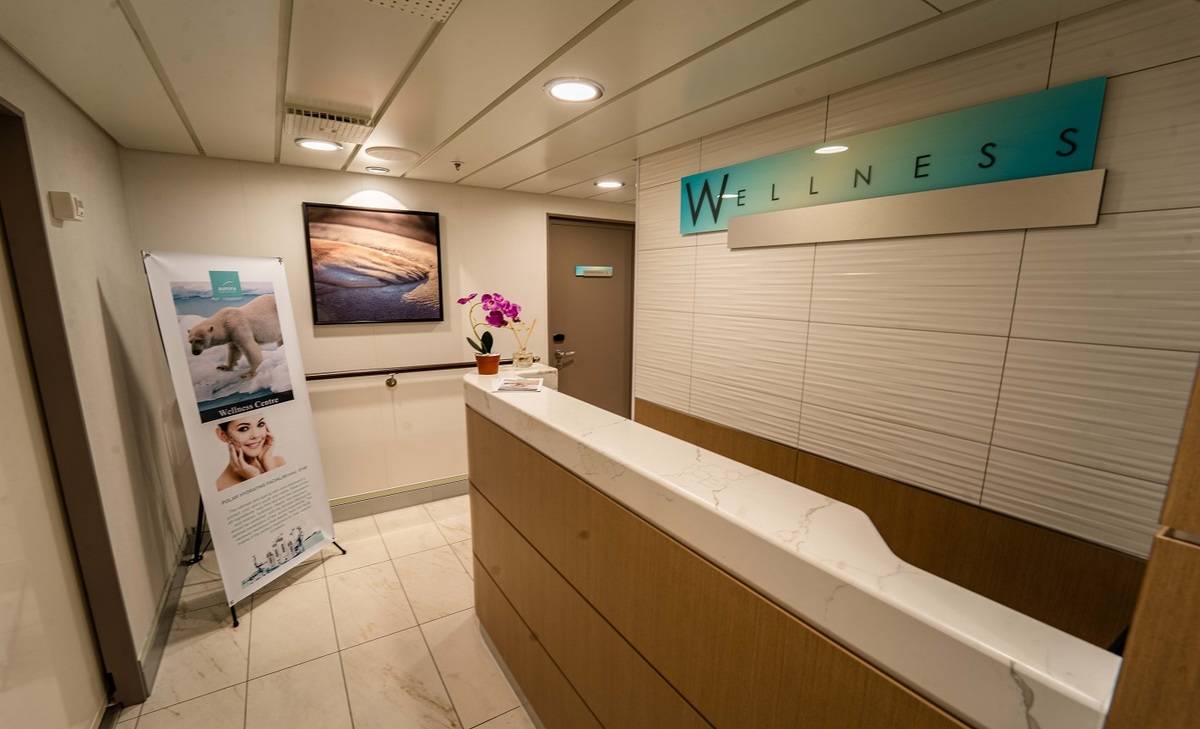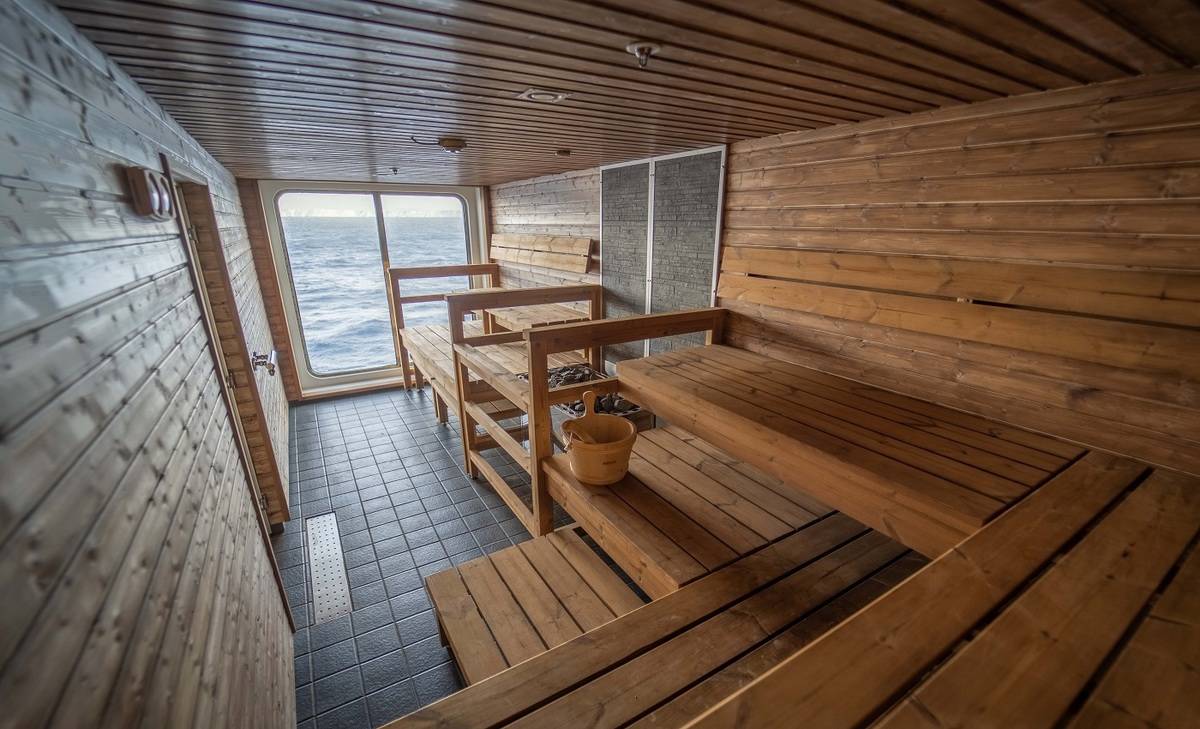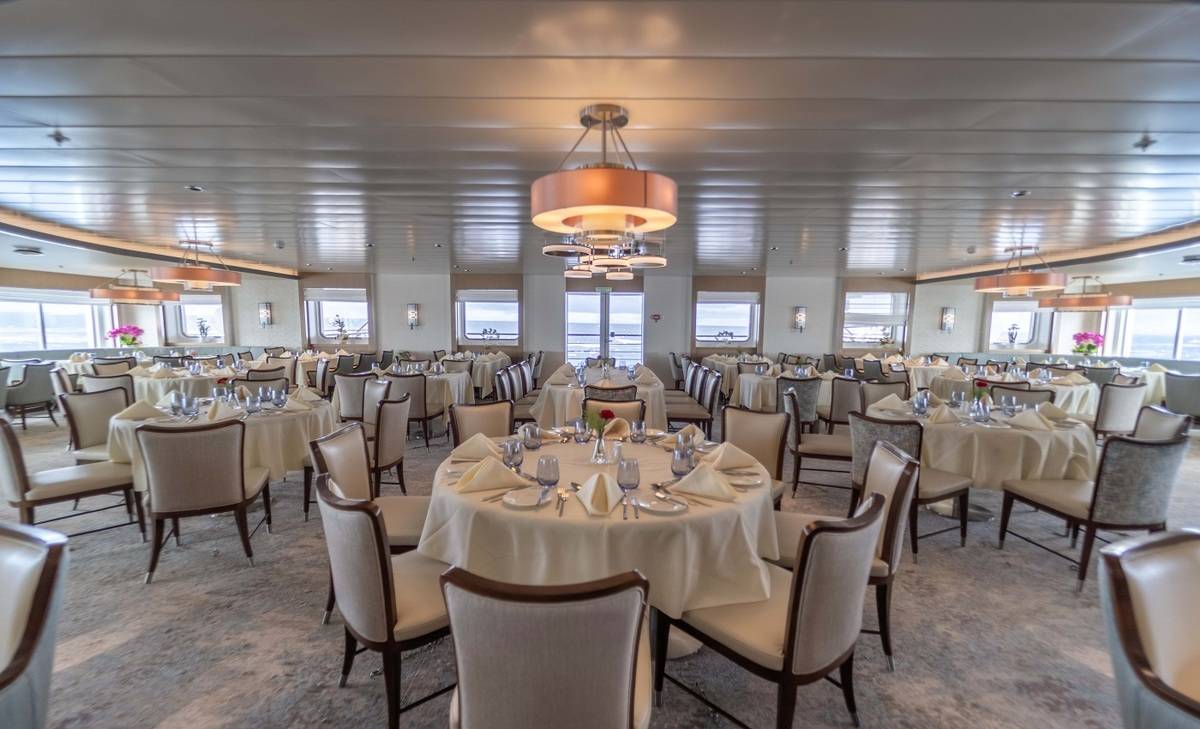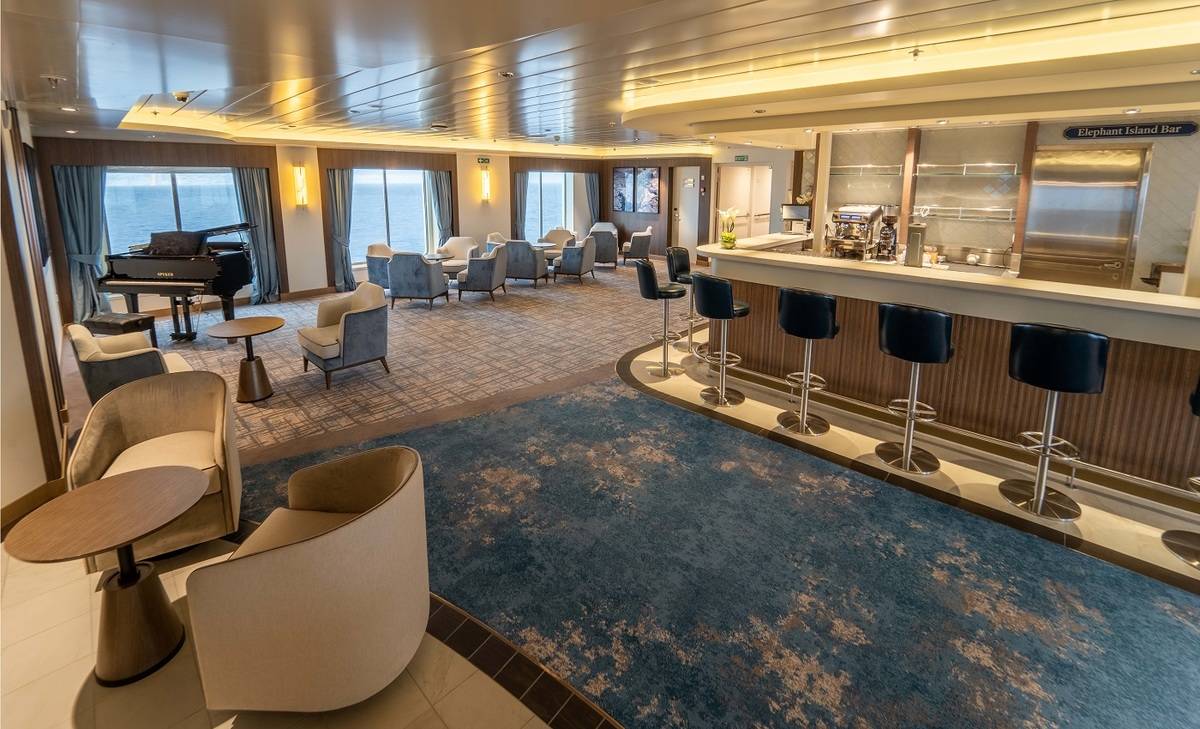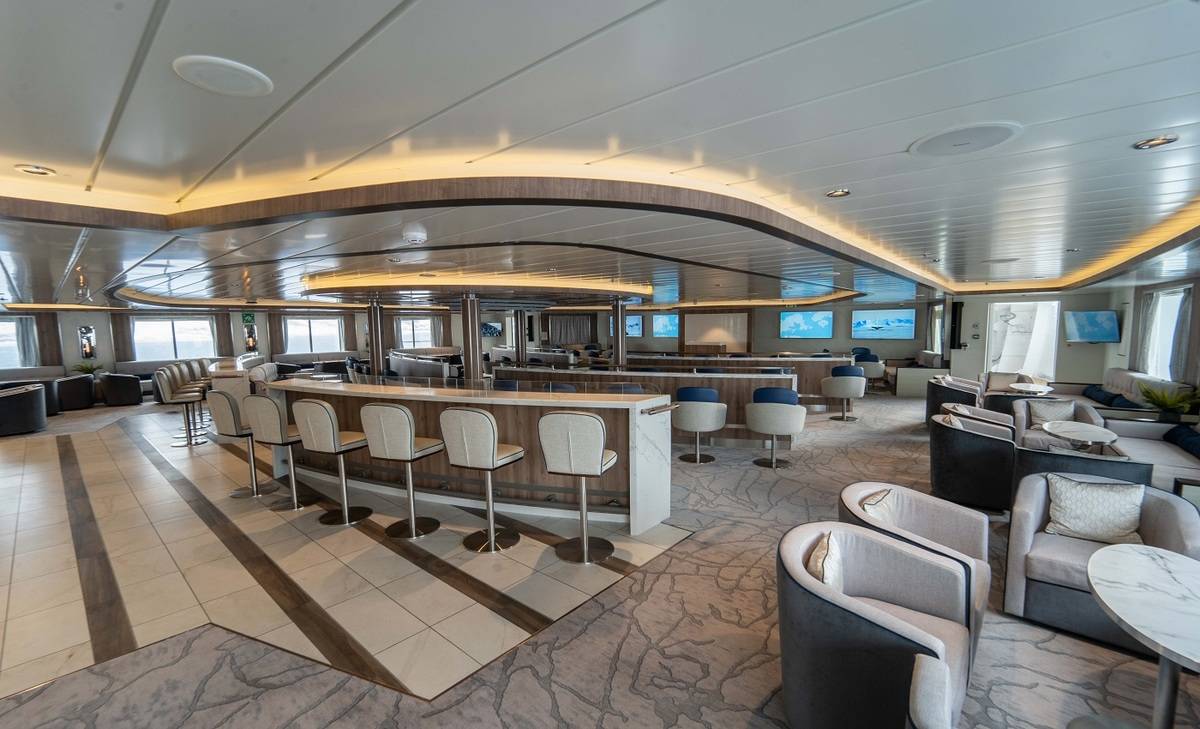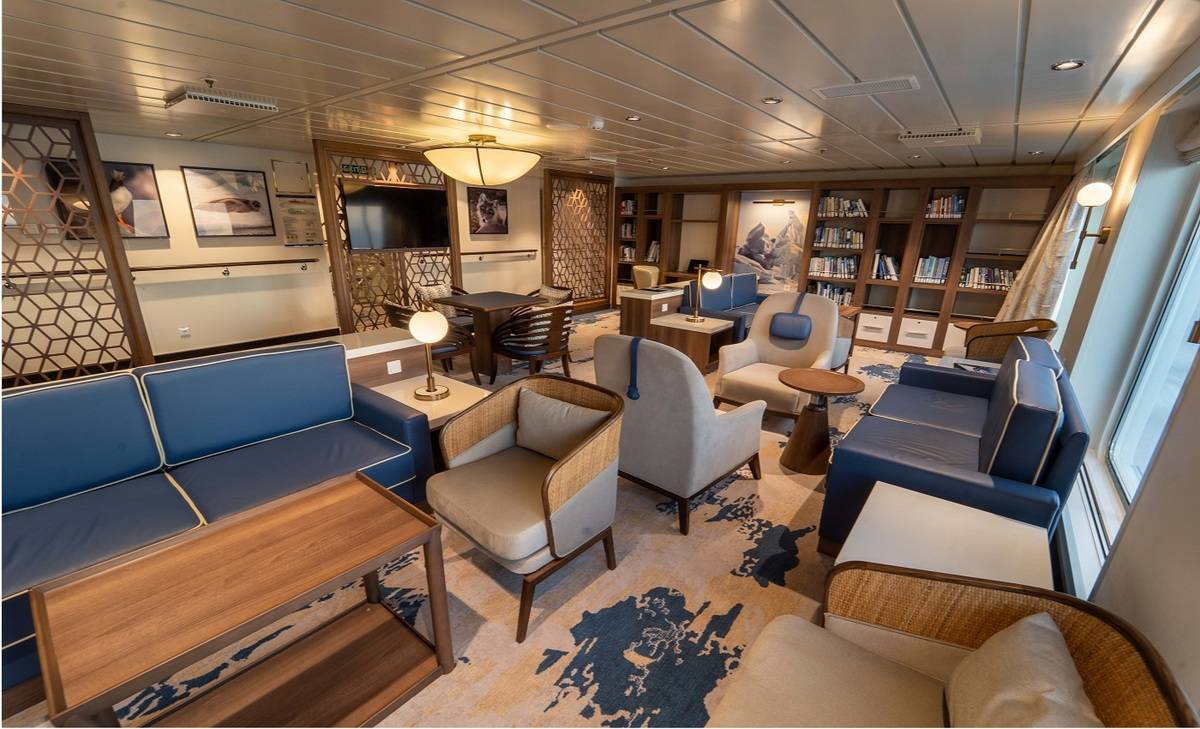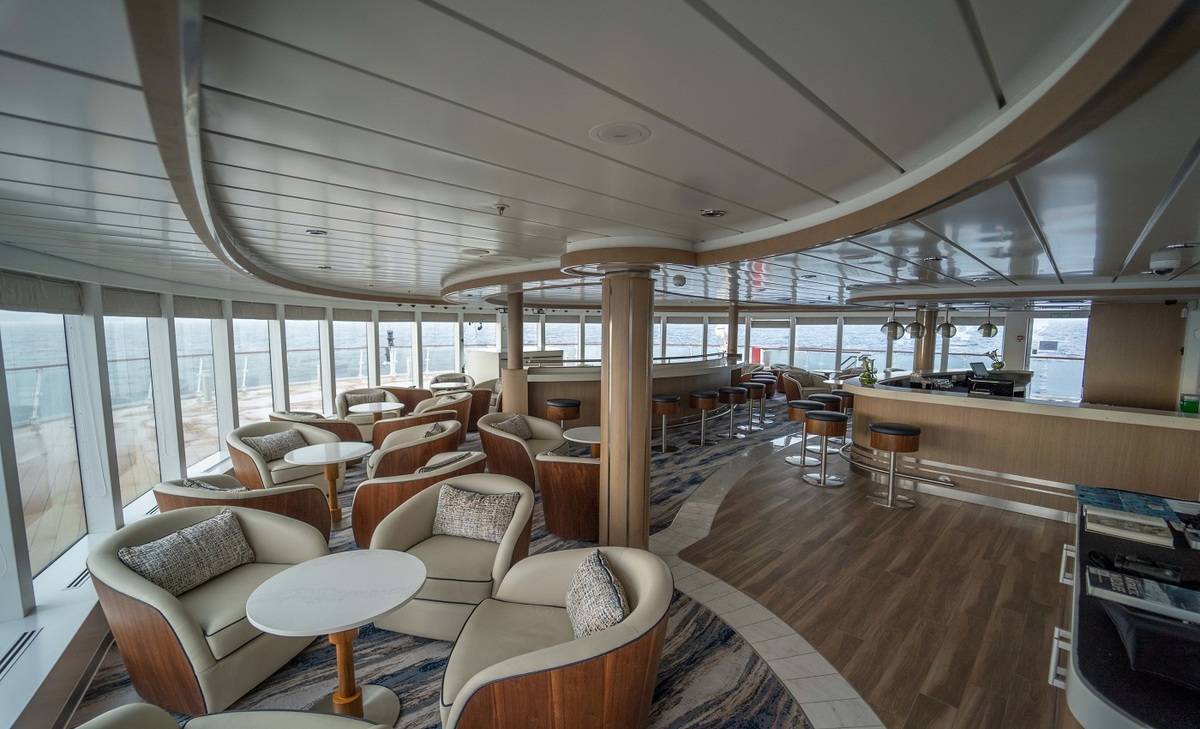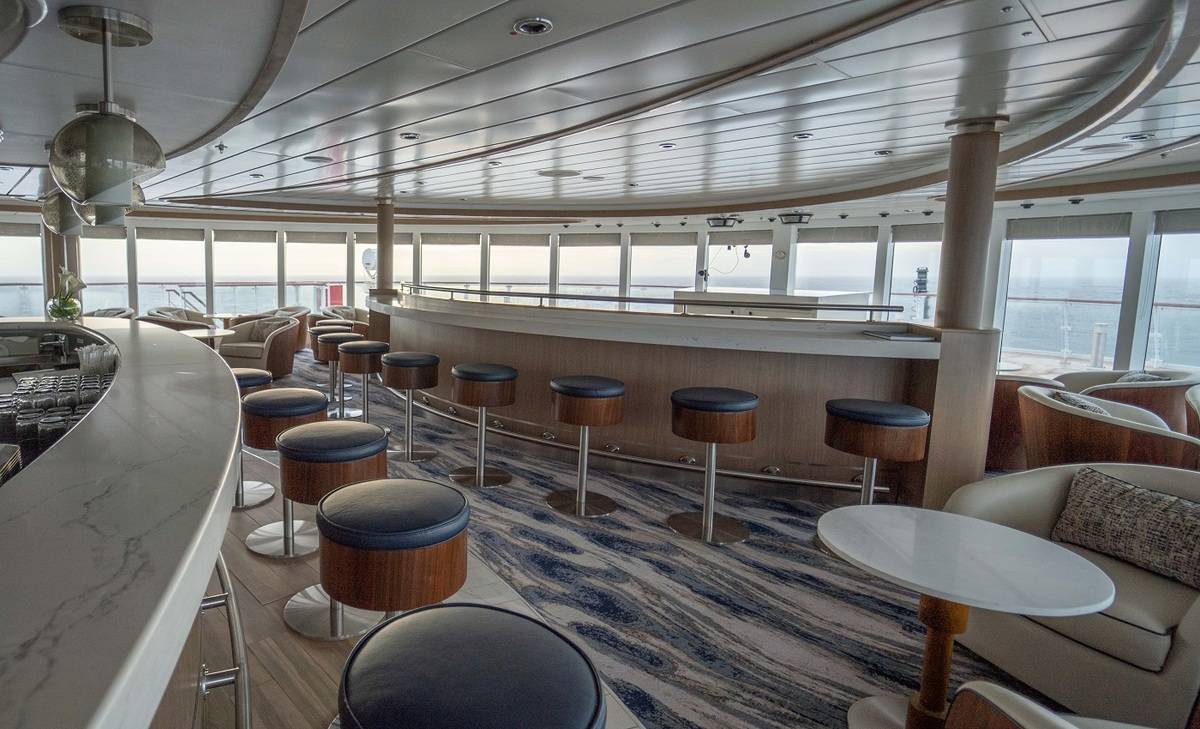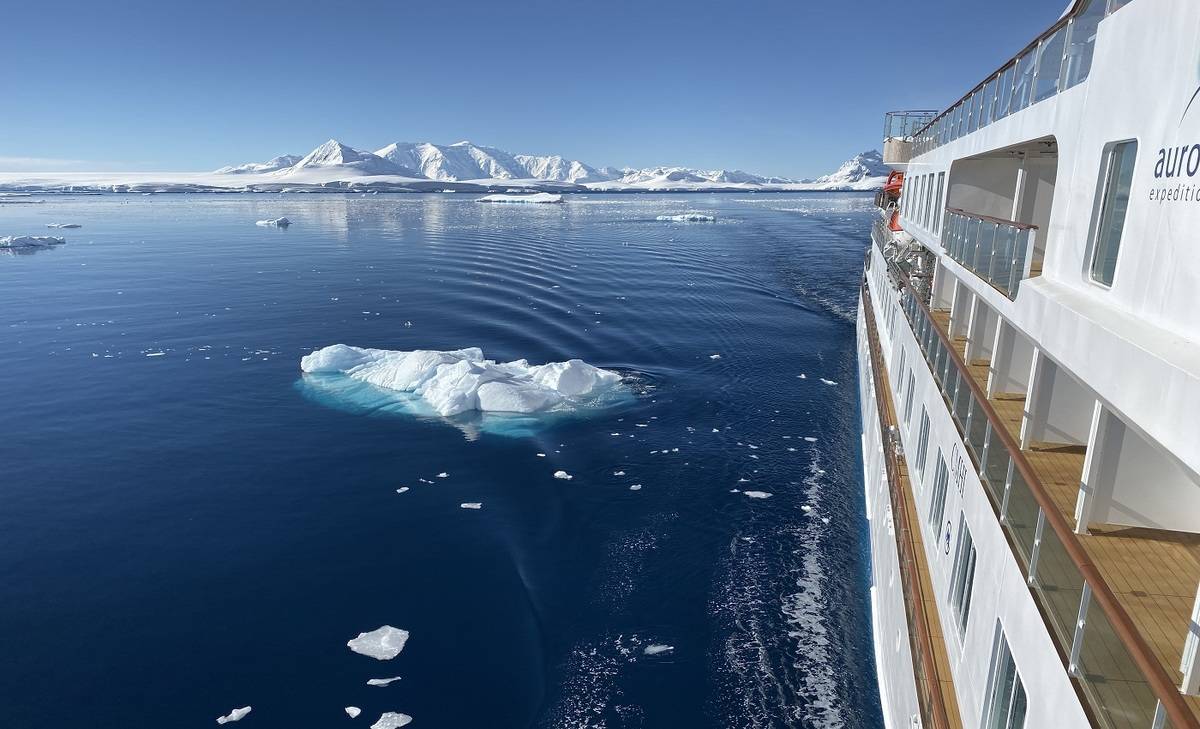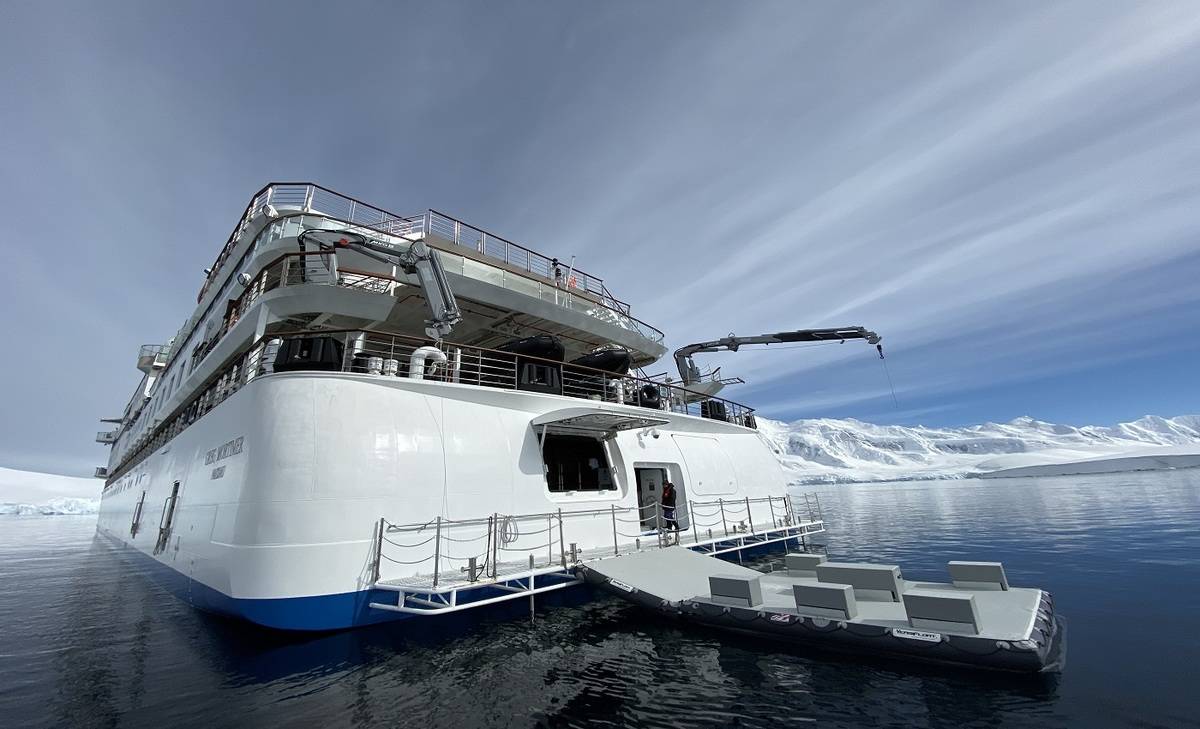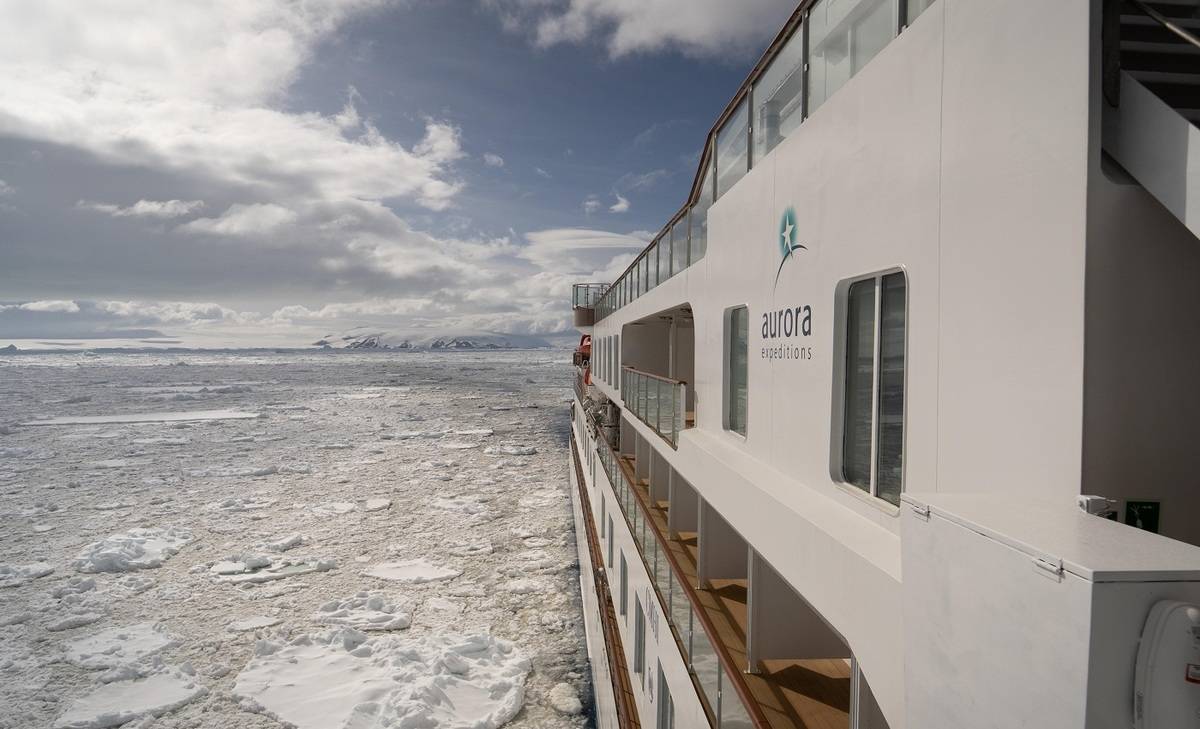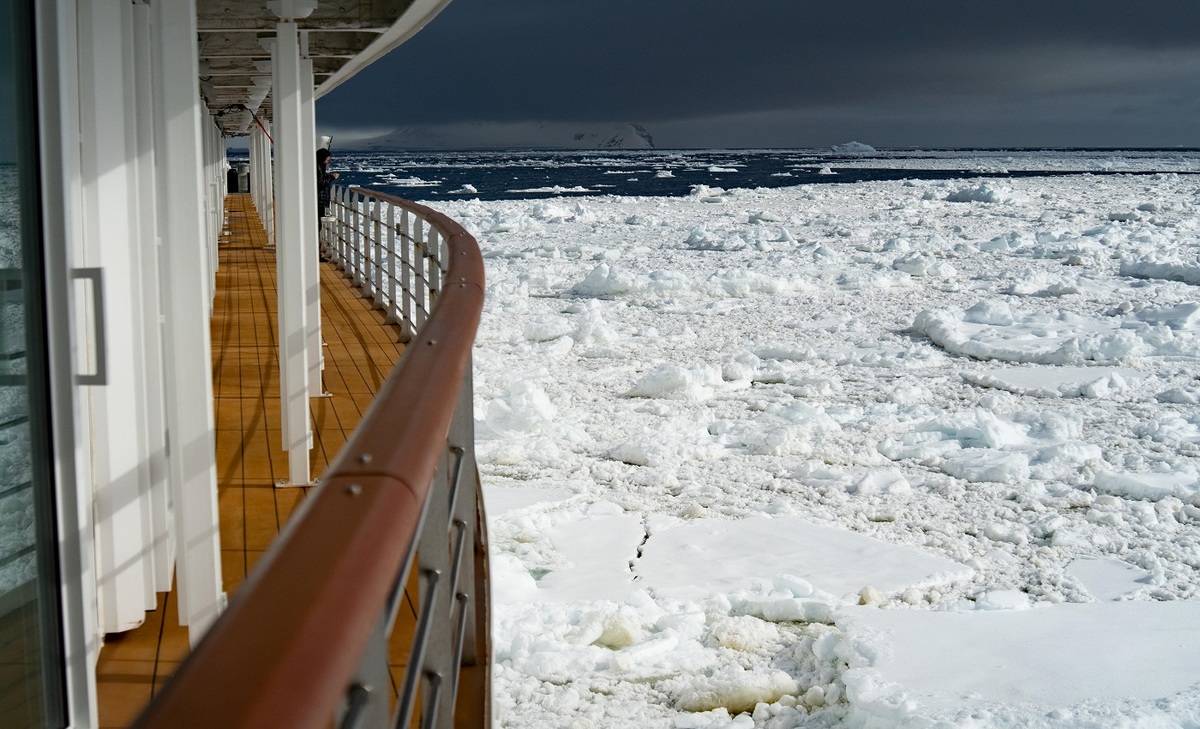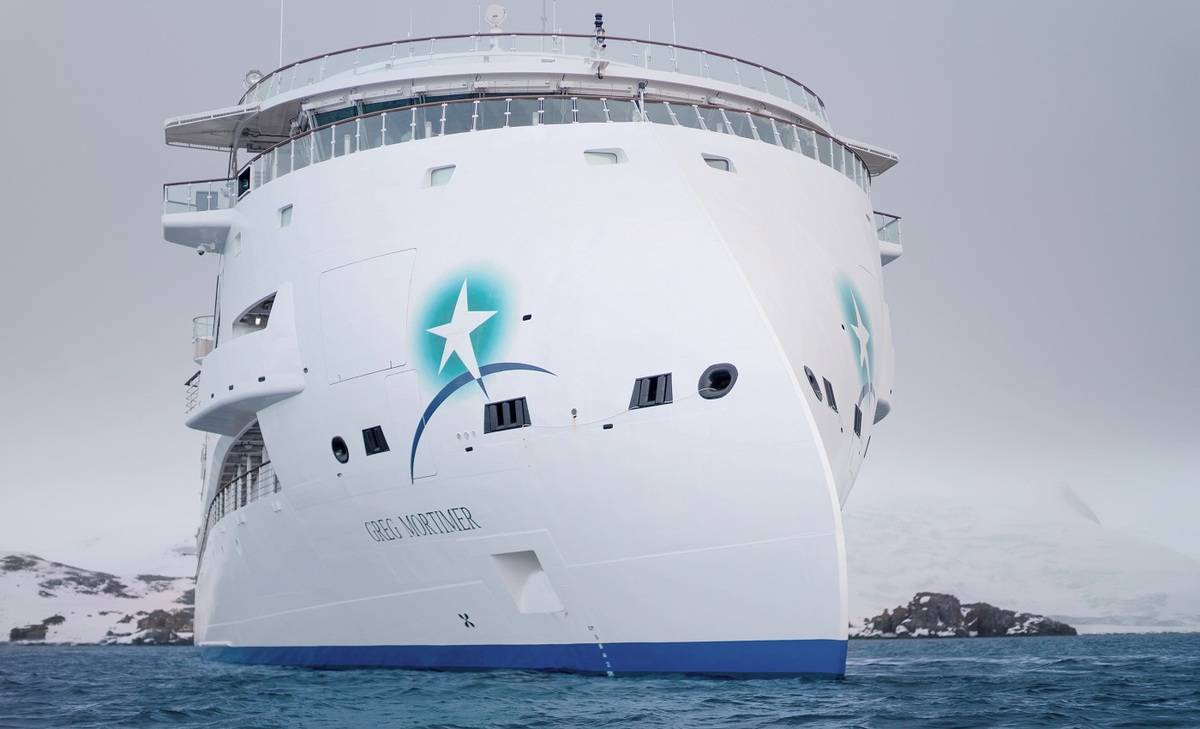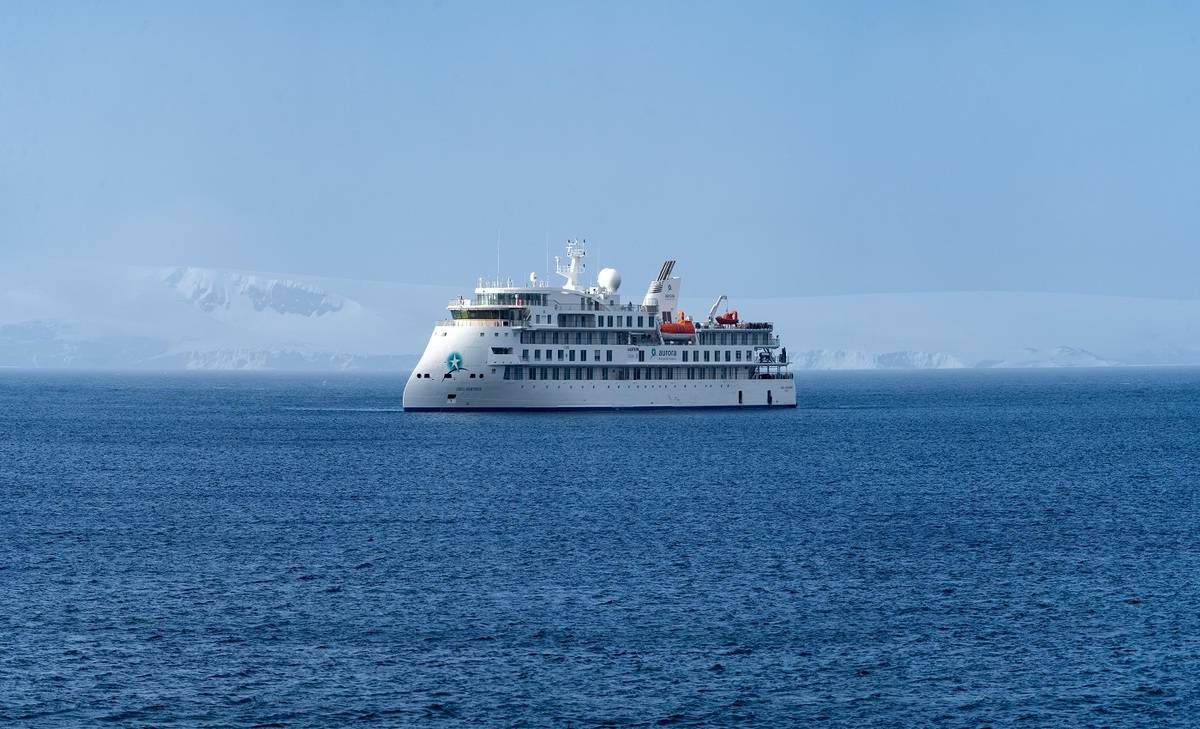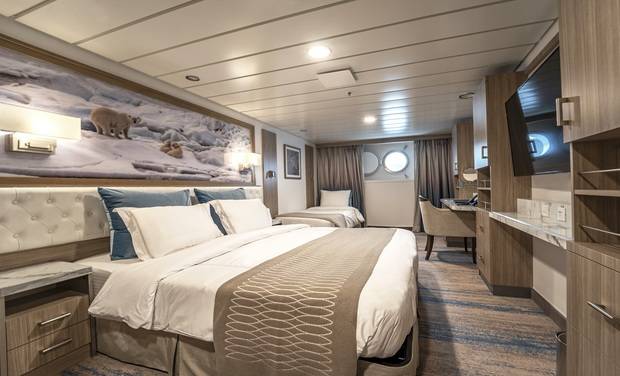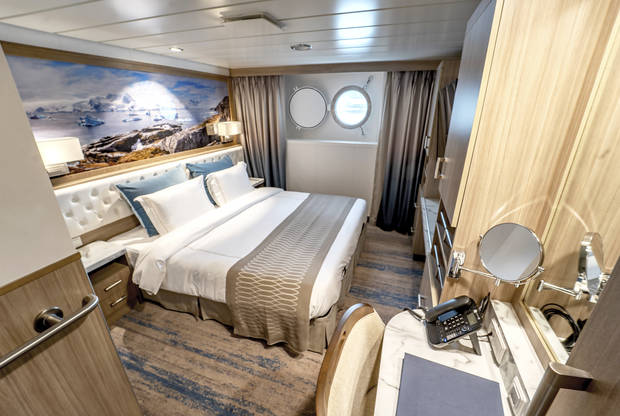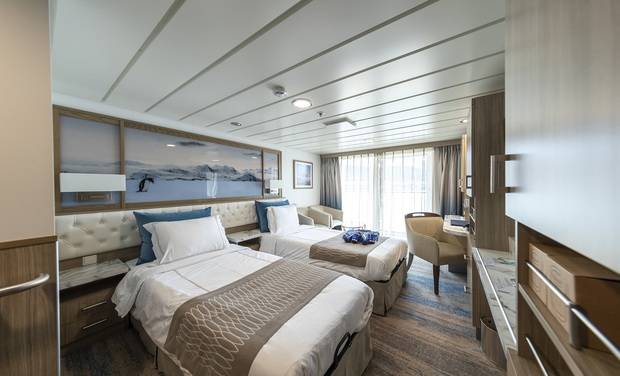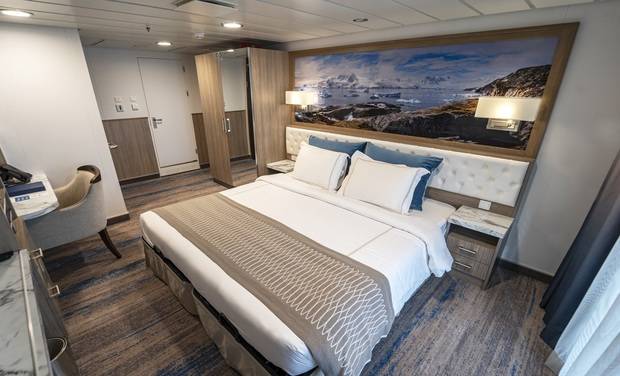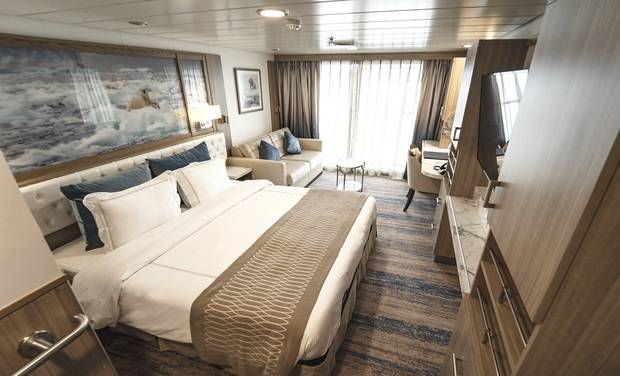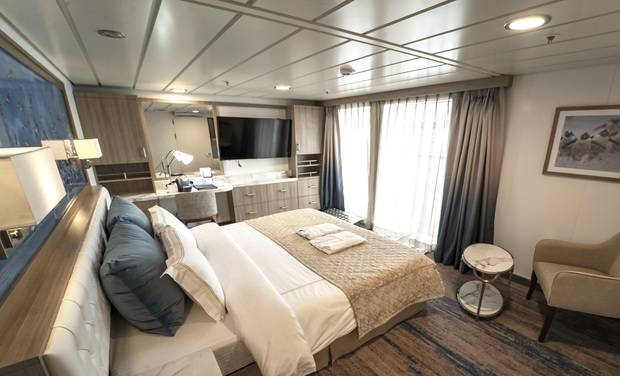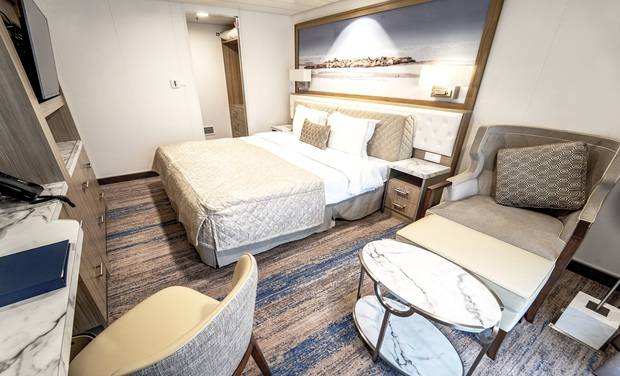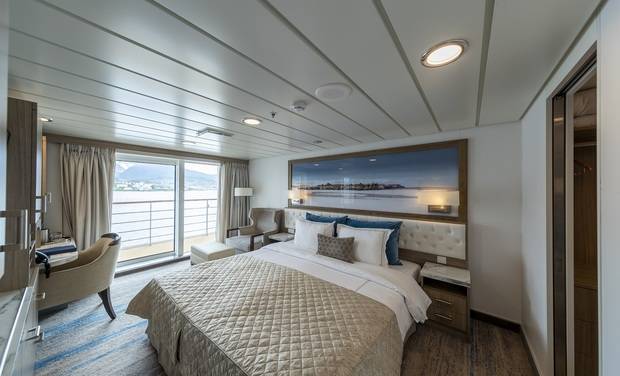Jewels of Coast UK
14 Days - Greg Mortimer
Discover some of the United Kingdom’s most historically significant and wildlife-rich destinations on this voyage from Portsmouth to Aberdeen. With numerous islands located in the Atlantic Ocean, a vast amount of the UK coastline is ideal for exploration by ship. In England, Wales and Scotland, there are designated Heritage Coasts, some which fall within national parks and Areas of Outstanding Natural Beauty, and some standalone coastal strips that are protected simply because they are part of a particular location’s heritage. Stroll through charming fishing villages, visit majestic castles, cathedrals, historical homes and gardens, encounter magnificent archaeological sites, witness a dazzling array of birds, and soak up the remarkable history of a land that has been continuously inhabited for over 5,000 years.
from USD $17795pp

Home » 14 Day Greg Mortimer: Jewels of Coastal UK
Itinerary Highlights
- Discover Portsmouth Historic Dockyard, home to two of the most iconic ships in British maritime history
- Be charmed by Cornwall’s dazzling coastline, castles, legends and iconic harbours
- Experience some of the UK’s most remarkable birdlife at Pembrokeshire Islands
- Visit Britain’s highest sea cliffs at UNESCO World Heritage-listed St Kilda
Itinerary in Brief
- Day 1: London
- Day 2: Portsmouth, embarkation
- Day 3: Fowey, Cornwall
- Day 4: Tresco, Isles of Scilly
- Day 5: Penzance, Cornwall
- Day 6: Lundy Island, England
- Day 7: Pembrokeshire Islands, Wales
- Day 8: Holyhead, Wales
- Day 9: Douglas, Isle of Man, England
- Day 10: Islay, Scotland
- Day 11: Iona and Staffa, Scotland
- Day 12: St Kilda, Scotland
- Day 13: Fair Isle and Papa Westray, Scotland
- Day 14: Aberdeen, disembark
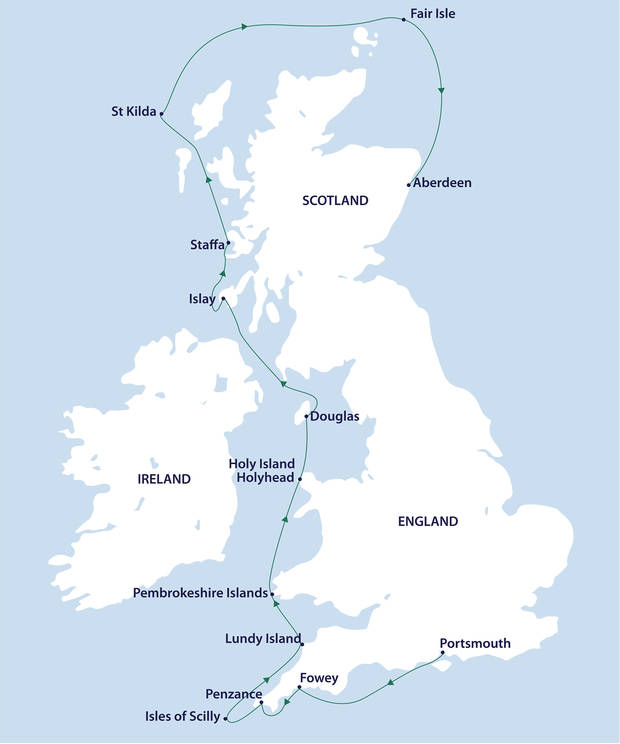
Day 1: London
Having made your way to London's Heathrow, Gatwick or London City airport, you will be met by a representative and will transfer to your pre-voyage hotel. Visit the hospitality desk, located in the lobby. Our team will run through your embarkation day, answer your questions, and give advice on the local area. They will also provide you with cabin tags for your luggage. Please clearly label the tags with your name and ship cabin number. The remainder of your time is at leisure to enjoy London. All meals today are at your own expense.
Accommodation: Sheraton Grand London Park Lane (or similar)
Day 2: Portsmouth, embarkation
Check-out and bring your luggage to the lobby ready to be delivered to your cabin ahead of your arrival on board. Please ensure that your luggage is fitted with cabin tags clearly labelled with your name and cabin number. Any valuables or personal items should be kept with you throughout the day.
We drive two hours south to the Portsmouth Historic Dockyard. This openair museum is home to two of the most iconic ships in British maritime history: Mary Rose and HMS Victory. The Mary Rose, Henry VIII’s flagship, which capsized while fighting the French in 1545, was recovered from the seabed in 1982. In dry dock alongside the Mary Rose, is HMS Victory. Constructed in the 18th century and famed for her part in the Battle of Trafalgar in 1805, Victory was the flagship of Admiral Lord Nelson. The recreation of ‘onboard life’ returns us to height of the battle whilst walking amongst the Dockland’s shipping relics highlights Britian's naval history. Please note that as a working naval base, you are not able to leave luggage anywhere on site. Unattended items may be confiscated or destroyed.
Join your guide on your tour of this coastal city at Spice Island, where we discover some of the city’s historical buildings and defences as well as the headquarters of Britain’s America’s Cup team. We gain an insight into how Portsmouth has shaped England’s story across the centuries, as home to its favourite son, Charles Dickens, and Sir Arthur Conan Doyle, who began writing his Sherlock Holmes stories while practising as a doctor in the seaside suburb of Southsea.
Returning to the port, settle into your cabin before attending important safety briefings and enjoy the thrill of departure as we ‘throw the lines’ and set sail. This evening, get to know your fellow expeditioners and our friendly Expedition Team and crew at the Captain’s Welcome Dinner to celebrate the start of a thrilling adventure.
Day 3: Fowey, Cornwall
Located on the south coast of Cornwall, Fowey has a strong Celtic connection and is steeped in maritime history. The buildings of Fowey tell the tales of its past. The ancient castles at the deep-water entrance once guarded the harbour from Spanish fleets and, in the heart of the town, the towers of the 14th-century St Fimbarrus Church and the 15th-century Place House still stand proud. Our ship will take centre stage on its mooring right in the heart of Fowey. While you immerse yourself in the Cornish lifestyle, the ship will be the talk of the town.
Coastal Hike
Depart Fowey Harbour by coach for the scenic drive to the fishing village of Gorran Haven. Set off on foot through the narrow medieval streets towards the beach, before continuing uphill to the cliffs from where the hike along the southwest coast path begins. The route takes you through wild meadows and along clifftop paths, offering magnificent panoramas.
The coastal path descends towards Turbot Point, where the sheer cliffs are known as Bodrugan’s Leap, after Sir Henry Bodrugan, who made his escape from his pursuing enemy, Sir Richard Edgcumbe of Cotehele, by leaping from the cliff into a boat that took him to safety in France. Taking in Chapel Point en route, continue to Port Mellon, a delightful cove with a long history of boat building.
As the route nears closer to the end of the walk, glimpse a first view of Mevagissey and the lovely sweep of Mevagissey Bay. As the lane descends, see splendid views of the picturesque harbour, before arriving for free time to enjoy Mevagissey at leisure. Perhaps explore the village, relax and soak up the scenery, or visit one its many charming cafes for a Cornish cream tea (not included).
Lost Gardens of Heligan
Depart Fowey for the one-hour journey to the magical Lost Gardens of Heligan. Your route crosses a peaceful countryside of small villages and granite farmhouses, giving you glimpses of life here in days gone by and the hedged fields that give way to rolling downs as you approach Heligan, which is the Cornish name for the willow tree.
The Lost Gardens, situated near the fishing village of Mevagissey, are set on 80 hectares (200 acres) and include a complex of walled gardens, greenhouses and a huge vegetable garden. The gardens are claimed as the site of the largest garden restoration in Europe.
As if from a fairytale, the 57-acre gardens were lost for 70 years beneath a mass of ivy, brambles and fallen timber. In 1991, they were ‘rediscovered’ and have been beautifully restored to incorporate rockeries, summerhouses and a crystal grotto. Explore the gardens on your own and marvel at this once-forgotten world. Stroll, or stop and perch on a bench, of which there are many dotted throughout the gardens, to enjoy the tranquil environment offered by the plants and birdlife.
As well as being named ‘Large Attraction of the Year 2018/19’ at the Cornwall Tourism Awards, the Lost Gardens of Heligan also won the prestigious British Travel Award for Best UK Leisure Attraction in both 2016 and 2017.
Enjoy some free time exploring Fowey at your own pace. Fowey is a picturesque port town dominated by its links to fishing, shipbuilding, trading and privateering. Stroll along the narrow streets, dating back as far as the 15th century, to Fowey Town Quay, from where you can enjoy fantastic views of Polruan on the opposite shore. See the ‘Rook with a Book’ sculpture created to celebrate the famous writer Daphne du Maurier, who lived in Fowey – the local area being the inspiration and setting for her well-known novels Rebecca, My Cousin Rachel and her short story, The Birds, famously adapted for film by Alfred Hitchcock.
You might want to visit Readymoney Cove, walking through woodland to the ruins of St Catherine’s Castle before returning to Albert Quay where our vessel awaits.
Day 4: Tresco, Isles of Scilly
Located on the south coast of Cornwall, Fowey has a strong Celtic connection and is steeped in maritime history. The buildings of Fowey tell the tales of its past. The ancient castles at the deep-water entrance once guarded the harbour from Spanish fleets and, in the heart of the town, the towers of the 14th-century St Fimbarrus Church and the 15th-century Place House still stand proud. Our ship will take centre stage on its mooring right in the heart of Fowey. While you immerse yourself in the Cornish lifestyle, the ship will be the talk of the town.
Coastal Hike
Depart Fowey Harbour by coach for the scenic drive to the fishing village of Gorran Haven. Set off on foot through the narrow medieval streets towards the beach, before continuing uphill to the cliffs from where the hike along the southwest coast path begins. The route takes you through wild meadows and along clifftop paths, offering magnificent panoramas.
The coastal path descends towards Turbot Point, where the sheer cliffs are known as Bodrugan’s Leap, after Sir Henry Bodrugan, who made his escape from his pursuing enemy, Sir Richard Edgcumbe of Cotehele, by leaping from the cliff into a boat that took him to safety in France. Taking in Chapel Point en route, continue to Port Mellon, a delightful cove with a long history of boat building.
As the route nears closer to the end of the walk, glimpse a first view of Mevagissey and the lovely sweep of Mevagissey Bay. As the lane descends, see splendid views of the picturesque harbour, before arriving for free time to enjoy Mevagissey at leisure. Perhaps explore the village, relax and soak up the scenery, or visit one its many charming cafes for a Cornish cream tea (not included).
Lost Gardens of Heligan
Depart Fowey for the one-hour journey to the magical Lost Gardens of Heligan. Your route crosses a peaceful countryside of small villages and granite farmhouses, giving you glimpses of life here in days gone by and the hedged fields that give way to rolling downs as you approach Heligan, which is the Cornish name for the willow tree.
The Lost Gardens, situated near the fishing village of Mevagissey, are set on 80 hectares (200 acres) and include a complex of walled gardens, greenhouses and a huge vegetable garden. The gardens are claimed as the site of the largest garden restoration in Europe.
As if from a fairytale, the 57-acre gardens were lost for 70 years beneath a mass of ivy, brambles and fallen timber. In 1991, they were ‘rediscovered’ and have been beautifully restored to incorporate rockeries, summerhouses and a crystal grotto. Explore the gardens on your own and marvel at this once-forgotten world. Stroll, or stop and perch on a bench, of which there are many dotted throughout the gardens, to enjoy the tranquil environment offered by the plants and birdlife.
As well as being named ‘Large Attraction of the Year 2018/19’ at the Cornwall Tourism Awards, the Lost Gardens of Heligan also won the prestigious British Travel Award for Best UK Leisure Attraction in both 2016 and 2017.
Enjoy some free time exploring Fowey at your own pace. Fowey is a picturesque port town dominated by its links to fishing, shipbuilding, trading and privateering. Stroll along the narrow streets, dating back as far as the 15th century, to Fowey Town Quay, from where you can enjoy fantastic views of Polruan on the opposite shore. See the ‘Rook with a Book’ sculpture created to celebrate the famous writer Daphne du Maurier, who lived in Fowey – the local area being the inspiration and setting for her well-known novels Rebecca, My Cousin Rachel and her short story, The Birds, famously adapted for film by Alfred Hitchcock.
You might want to visit Readymoney Cove, walking through woodland to the ruins of St Catherine’s Castle before returning to Albert Quay where our vessel awaits.
Day 5: Penzance, Cornwall
Nestled in a corner of glorious Mount’s Bay, Penzance has long been one of Cornwall’s gems. Soak up the olde-worlde pirate atmosphere as you discover the cobbled alleyways, winding streets, subtropical gardens and dockside taverns for which the town is famous. And do not forget to try an authentic Cornish pastie while in town.
Scenic Drive of Cornwall’s Highlights
Your scenic exploration of Cornwall’s highlights begins with a drive to St Ives Bay on the north coast. Passing near to author Rosamunde Pilcher’s birthplace of Lelant, the journey heads east towards Camborne and Redruth. Threading through narrow country lanes, past small granite cottages and stern Methodist chapels, with old, abandoned engine houses dotting the undulating landscape, we get a sense of a time when this area was the beating heart of Cornwall’s mining industry.
Rising high over Camborne and Redruth is the spectacular tor, Carn Brea, a 27-metre (90-foot) granite column built in 1836 as a tribute to Francis Bassett, a philanthropist and member of the most important mining family in the area.
Arrive in the maritime port of Falmouth, which sits on the county’s south coast at the end of the Carrick Roads Estuary. Falmouth is the traditional gateway to the Atlantic and one of the world’s greatest sailing harbours. After a comfort break, your journey continues towards historical Pendennis Headland, where the route ascends, offering a view over the dockyard below and a spectacular vista out across Falmouth Harbour. The headland is dominated by Pendennis Castle, one of the finest of the mighty fortresses built by Henry VIII to defend the Cornwall against invasion.
The route ventures past the golden sand of Gyllyngvase Beach as you set off west to the quaint market town of Marazion. From here, pause to enjoy spectacular views of the world-renowned St Michael’s Mount. Separated from the mainland by a tidal causeway, this is no dusty museum or dormant relic of a past life. Home to a bustling island community, life on this craggy island is ruled by the tides and weather, with crystal-clear waters lapping the shores during the summer months and waves lashing the steep cliffs during winter storms.
It will then be time to board the coach for the short journey back to the vessel for lunch.
Pendeen to Botallack Coastal Walk
After a short transfer by coach from Penzance port, arrive at Pendeen, where the Pendeen Watch Lighthouse has been guiding passing vessels and warning of the dangerous waters around Pendeen for nearly 100 years. Head off on a guided exploration hike of Cornwall’s fascinating mining heritage, stopping at the dramatic clifftop setting of Levant. Levant was known as ‘the queen of Cornwall’s submarine mines’ because of its undersea levels at a depth of over 600 metres (1,968 feet), which stretched over a kilometre (one mile) out to sea. Today, the surviving buildings and ruins offer a window to another world, where men and women toiled to extract the riches of the earth from beneath the crashing waves.
Enjoy the delightful walk along the coastal path dotted with iconic mine chimneys and engine houses, to Botallack Mine, a UNESCO World Heritage Site. Botallack’s World Heritage status testifies not only to the importance of its historical features, but also to the importance of the mining landscape and the technological developments and scientific research that took place here. The Cornish had a huge influence on the development of mining throughout the world, with over 250,000 people having left Cornwall between 1815 and 1915 to work in other mining areas. It is estimated that there are six million people of Cornish descent globally. The Botallack Mine Count House and the world-famous Levant Beam Engine have both been restored by the National Trust and are key monuments at the Cornish and West Devon Mining Landscape World Heritage Site.
After a fascinating exploration of the Cornish coast, board your coach for the short return journey to Penzance.
Day 6: Lundy Island, England
Lundy Island is owned by the National Trust and managed by the Landmark Trust. The island enjoys a milder climate than the mainland, with more hours of sunshine and less rain. The diversity of the island's flora and fauna attracts walkers, climbers and divers from near and far.
Despite its small size, Lundy Island offers a diverse range of activities to visitors. Its 4,000 years of human history comes to life through the 42 scheduled monuments and its clutch of listed buildings. Lundy’s position, with the Atlantic Ocean to the west and the Bristol Channel to the east, creates a unique combination of environmental conditions, which have created habitats that support a variety of rare and spectacular wildlife. The rugged cliffs of the west coast are carpeted with sea grass species and are home to important seabird colonies, including puffins and Manx shearwaters. In comparison, the relatively sheltered and calm east coast boasts spectacular displays of wildflowers and provides sanctuary to migrating birds in the spring and autumn.
The diversity of marine life is as equally impressive as the life on land, with many rare and remarkable species protected in both reef and sandbank habitats. Lundy has a population of approximately 200 Atlantic grey seals that are often seen hauled out on the rocks enjoying the sun or frolicking in the water. During summer, basking sharks, the world’s second largest fish, often come to Lundy to feed in the island’s plankton-rich waters. The clifftops on the south-east coast of Lundy are said to be the best place on the island to see dolphins, whales and porpoises. Large numbers of feeding gannets can indicate the presence of a shoal of fish, which can entice a passing whale, dolphin or porpoise.
Day 7: Pembrokeshire Islands, Wales
Skomer, Skokholm and Grassholm are a trio of neighbouring islands named by ancient Viking visitors. They are located off the coast of southern Pembrokeshire and are celebrated for their exceptional wildlife. The islands are a Site of Special Scientific Interest and are included within the Pembrokeshire Coast National Park in West Wales.
Skomer, the larger island, has a thriving puffin colony and these quirky birds with their iconic black and orange beaks are a big draw for visitors. Manx shearwaters are also found on the island, and at night, listen out for the cacophony of eerie sounds they make as they return from hunting.
Nearby Skokholm is more rugged. Its cliffs slant into the Irish Sea, which crashes around its edges, creating a wild and dramatic landscape for photographers.
Tiny, isolated Grassholm is the westernmost point of Wales and is situated 18 kilometres (11 miles) from the Pembrokeshire mainland. It is known for its famous gannet colony and the dolphins, porpoise and grey seals that visit the area.
To protect the wildlife on the Pembrokeshire Islands, daily visitor numbers are heavily restricted. We are very fortunate to be able to explore the splendid coastline of the islands from our ship, or in Zodiacs or kayaks.
Day 8: Holyhead, Wales
Expect a warm Welsh welcome in North Wales. Holyhead is the largest town on the island of Anglesey and has a reputation for being a busy ferry port. It is also the gateway to Snowdonia and the North Wales coast.
Caernarfon Castle
Take the scenic journey across Anglesey and the Menai Strait to Caernarfon, with its famous castle dating from 1283. Standing at the mouth of the Seiont River, the fortress with its unique polygonal towers, intimidating battlements and colour-banded masonry, dominates the walled town.
Of the four castles in northern Wales built by the order of Edward I, Caernarfon Castle is the most magnificent. The grandeur of Caernarfon Castle signifies King Edward I’s intent that it should serve as the powerful seat of English government in Wales. It is said to have been designed to echo the walls of Constantinople, the imperial power of Rome, and the ‘fairest that ever man saw’ dream-castle of Welsh myth and legend.
Caernarfon’s symbolic status was emphasised when Edward I made sure that his son, the first Prince of Wales, was born here in 1284. A statue of King Edward II can be seen above the entrance at the King’s Gate. In more recent times the heir to the UK throne, Prince Charles, was crowned Prince of Wales here in 1969.
Enter this once-impregnable castle and explore its magnificent ruins with your guide. Afterwards, enjoy free time to explore further, or visit the Royal Welsh Fusiliers Museum, housed in two of the castle’s towers.
Caernarfon town is adjacent to the castle and a good option to spend free time before returning to Holyhead.
South Stack RSPB Reserve
Anglesey is a wonderful place to see seabirds! On Holy Island, you will discover the wonderful South Stack Royal Society for the Protection of Birds (RSPB) Reserve. The area is covered in heathland on a stretch of beautiful, dramatic sea cliffs.
South Stack RSPB Reserve is an important nesting site for seabirds. The number of seabirds that nest on the cliffs here is impressive. Here you will find puffins, guillemots, razorbills, shags, kittiwakes and fulmars.
South Stack is one of the best places to see the chough (pronounced ‘chuff’). The chough is the rarest member of the crow family in the British Isles and can be seen swooping along the cliffs year-round. An important conservation project is currently underway at the reserve to encourage choughs to breed.
Other wildlife that you may see include the rare silver-studded blue butterfly and basking adder. If you look out to the sea, you may spot porpoises and dolphins.
In summer, the heathland, which is part of the largest maritime heathland in North Wales, has an abundance of plant species, including the spotted rock rose, the county flower of Anglesey, and spathulate fleawort, which is endemic to Anglesey but only found at South Stack.
After the guided walk, enjoy some time to explore independently.
Day 9: Douglas, Isle of Man, England
The Isle of Man is a self-governing British Crown Dependency in the Irish Sea between England and Ireland. Its coastline features cliffs, stacks, islets and long beaches, while the hills hold important peat reserves and are deeply cut by wooded glens in the east. In recognition of its rich marine biodiversity, the Isle of Man has been designated a UNESCO Biosphere Reserve.
Volcanoes & Vikings Walking Tour
This is one of the most beautiful walks on the island, renowned for its stunning coastal scenery, birdlife and archaeological remains. Leaving the port at Douglas, travel via the famous Fairy Bridge to Castletown, the former capital of the Isle of Man.
Follow part of the Way of the Gull, the Isle of Man’s long-distance coastal footpath around Scarlett Head, where there is an opportunity to see seabirds and various plants against a stunning backdrop of limestone outcrops and volcanic rocks. This part of the exposed southern coast has an abundance of historical sites. There are traces of ancient forts, chapels, old farms, a WWII radar station and a now disused flooded quarry, which once supplied stone for the steps of St Paul’s Cathedral in London.
The historical highlights of the walk are at Chapel Hill, Balladoole. Here you can see a Bronze Age burial site, an Iron Age hillfort, a Viking ship burial site, and Keeill Vael, the remains of St Michael’s Chapel, which dates back to the 12th century. Chapel Hill has panoramic views over the south of the Island and the Iron Age Norse fort at The Enclosure of the Stallion.
Cregneash and The Sound
Depart Douglas and travel via the scenic Plains of Heaven and the Southern Hills, from where the magnificent panorama of the southern coast can be seen on the descent to Port St Mary village and the heritage hamlet of Cregneash.
Cregneash is one of the last strongholds of the Manx language, and this small village of white-washed, stone-walled thatched cottages (crofts) is one of the most picturesque villages in the Isle of Man. The residents of Cregneash play an important role in preserving the Manx heritage by using traditional methods of farming such as horse-drawn ploughs and allowing livestock to roam free. Expect to see sheep, shorthorn cows and Manx cats. Stroll around the village, venture inside the crofts to get a glimpse of traditional life and speak with the friendly folk that keep this wonderful heritage alive.
Afterwards, travel to The Sound, the most southerly point on the island and one of the most scenic places in the British Isles. Seals are often spotted lying on the rocky islet of Kitterland, and dolphins and basking sharks are also spotted in the water here. Look across to the Calf of Man, a renowned bird sanctuary where many migrating birds stop for a rest on their long journey to or from warmer climates.
Birdwatching Expedition
Note: This is a full-day excursion and is limited to 24 people. Bookings are confirmed on a first-to-book basis.
The Isle of Man is home to spectacular wildlife and birdlife. Bird species such as hen harrier, red-billed chough, peregrine, black guillemot, Manx shearwater, puffin, arctic tern and many more can be spotted on the island in remarkable habitats of exceptional beauty. Join your guide, a specialist ornithologist, to explore some of the wonderful wildlife areas and nature reserves on the island and discover the Isle of Man’s rich, diverse birdlife. Lunch at a local pub or restaurant is included.
Day 10: Islay, Scotland
Islay is the southernmost of the Inner Hebrides of Scotland and is known as the ‘Queen of the Hebrides’. The island has a population of approximately 3,200 inhabitants and an impressive coastline that stretches for 210 kilometres (130 miles).
Islay is probably best known for its malt whiskies and has eight working distilleries. Whisky is one of the most important sources of income for the island. On the south coast of Islay we visit Ardbeg Distillery, which was established by local farmers, and distiller John MacDougall began commercial production in 1815. Today, it is one of the island’s fastest-growing distilleries and prides itself for using entirely traditional methods of production. Using malted barley sourced from the maltings at Port Ellen, Ardbeg claims to produce the peatiest whisky in Islay.
Besides whisky, Islay has an abundance of wildlife and is an important location for migrating birds. You will visit the RSPB reserve at Loch Gruinart, where you join the ranger for a guided walk through a variety of wetland habitats. With over 200 species of birds visiting Islay, you may see oystercatchers, gannets, terns, cormorants, buzzards, barnacle geese, white-fronted geese, hen harriers and even white-tailed eagles. From the beaches, seals, dolphins and basking sharks are sometimes spotted, and if you are patient, you might even see otters.
History abounds on Islay. Standing stones, and a stone circle, show that the island was inhabited during Neolithic times. Islay was once known as the Lordship of the Isles, and you can explore the 14th-century settlement at Finlaggan, which remains the most important archaeological site on the island. A number of Celtic crosses can also be found.
You will also visit the Islay Woollen Mill, which was established in 1883 and is Isla’s only mill. The mill is a traditional family-run business and uses two looms dating from Victorian times. The mill has made designs that were featured in Hollywood blockbuster films such as Braveheart and Forrest Gump.
Day 11: Iona and Staffa, Scotland
We aim for the tiny island of Iona. Barely five kilometres (three miles) long, Iona is renowned as the birthplace of Christianity in Britain. It is also the burial ground of early Scottish Kings. The Irish abbot Saint Columba and 12 disciples landed here and founded a monastery in 563. From this base, Saint Columba set about converting Scotland and much of Northern England to Christianity.
On Staffa, we hope to have the chance to explore Fingal’s Cave, where the melodious sound of waves crashing against towering basalt pillars inspired Felix Mendelssohn’s Hebridean Overture. We may enter the cave in Zodiacs, or clamber ashore to walk into the mouth of the cave. On shore we will also find puffin in abundance.
Day 12: St Kilda, Scotland
Weather permitting, we plan to land at the isolated archipelago (and World Heritage Site) of St Kilda, where derelict crofts bear testament to the fortitude of islanders who once tended the unique Soay sheep and harvested seabirds for food – paying their rent in the form of wool, meat and feathers. The isles hold Europe’s most important seabird colony and is home to Britain’s highest sea stacks (rock columns). Island hopping north-east, we aim to visit tiny specks of land that bear the brunt of violent Atlantic storms and rarely see visitors.
Day 13: Fair Isle and Papa Westray, Scotland
Midway between Orkney and Shetland, Fair Isle houses a major European ornithological research station and is also famous for knitwear and historical shipwrecks. About five kilometres by three kilometres (three miles by two miles), Fair Isle is surrounded by impressive cliffs. The 70 or so islanders mainly live in traditional crofts on the more fertile low-lying southern part of the island.
A birdwatcher’s paradise, Fair Isle lies on the intersection of major flight paths from Scandinavia, Iceland and Faroe. In summer, the cliffs teem with breeding fulmars, kittiwakes, guillemots, gannets, shags and puffins. The isle is an excellent place to view seabirds, especially puffins, at close range. Fair Isle also has over 250 species of flowering plants, including wetland flowers, rare orchids, alpine species and common wildflowers. We will be welcomed by the hospitable villagers and may take a hike or visit the museum. Grey and common seals inhabit the waters around Fair Isle, and sharp eyes may spot harbour porpoises, white-beaked dolphins, Atlantic white-sided dolphins, orcas and minke whales.
On Papa Westray, you can choose to visit the 5,500-year-old Knap of Howar, a Neolithic farm building that claims to be the oldest standing house in Europe and the 12th century St Boniface Kirk. Alternatively, enjoy a walk at North Hill reserve in the north of the island. The reserve is home to Arctic terns and skuas and the extremely rare Scottish primrose. In the early evening meet at the Papay Pub for a drink with the locals.
Day 14: Aberdeen, disembark
During the early morning, we cruise into Aberdeen, where you will be free to disembark at approximately 8.00 am. Farewell your Expedition Team and fellow passengers as we all continue our onward journeys. Transfer to Aberdeen airport or to your centrally located hotel.
| Dates | Cabin | From | Special Offer |
|---|---|---|---|
| 04 May 2023 - 17 May 2023 | USD $17795pp | ||
| Aurora Triple Stateroom | USD $17795pp | Contact us | |
| Aurora Twin Stateroom | USD $18295pp | Contact us | |
| Balcony Stateroom (C) | USD $19895pp | Contact us | |
| Balcony Stateroom (B) | USD $20895pp | Contact us | |
| Balcony Stateroom (A) | USD $22495pp | Contact us | |
| Balcony Stateroom Superior | USD $24595pp | Contact us | |
| Junior Suite | USD $30795pp | Contact us | |
| Captain's Suite | USD $36595pp | Contact us | |
**Prices are per person based on twin / shared accommodation.
**Single supplements may apply
Cabin Details
Aurora Triple Stateroom
21.4 - 22.8sqm, located on deck 3, 3 single beds, private en-suite bathroom, porthole window, desk area, closet, room-controlled thermostat & 42" flat screen TV.
*Please note the Aurora Stateroom (Triple) cabins are only available on certain departures.
Aurora Twin Stateroom
15.8 - 22.8sqm, located on deck 3, 2 single beds, private en-suite bathroom, porthole window, desk area, closet space, room-controlled thermostat, safe & 42" flat-screen TV.
Balcony Stateroom (C)
20.9 - 24.8sqm (cabin + balcony), located on deck 4 & 6, twin or double bedding, private en-suite bathroom, floor to ceiling window, desk space, closet space, private balcony, room-controlled thermostat, safe & 42" flat screen TV.
Balcony Stateroom (B)
Standard Balcony Stateroom
23.6 - 24.8sqm (cabin + balcony), located on deck 4 & 6 (fore and aft), twin or double bedding, private en-suite bathroom, floor to ceiling window, desk area, closet space, private balcony, room-controlled thermostat, safe & 42" flat screen TV.
* Many fitted with interconnecting features making them great for families or groups.
Balcony Stateroom (A)
Premium and most abundant Balcony Stateroom
24.1 - 31.3sqm (cabin + balcony), located on deck 4 & 6 (close to internal stairs/elevator), twin or double bedding, private en-suite bathroom, floor to ceiling window, desk area, closet space, private balcony, room-controlled thermostat, safe & 42" flat screen TV.
Balcony Stateroom Superior
30.5 - 40.2sqm (cabin + balcony), located on deck 4, twin or double bedding, private en-suite bathroom, full size window, desk area, closet space, private balcony, room-controlled thermostat, safe & 42" flat screen TV.
Benefits:
- One free pair of binoculars per suite
- One free bottle of champagne per suite and free stocked mini bar (stocked once only)
- 1-hour massage or facial treatment per person
- Gratuities/tips for crew included - to the value of USD$15 per person per day
Junior Suite
38.9sqm (cabin + balcony), located on deck 7, twin or double bedding, private en-suite bathroom, full size window, desk area, closet space, private balcony, room-controlled thermostat, safe, 42" flat screen TV & separate lounge area.
Benefits:
- One free pair of binoculars per suite
- One free bottle of champagne per suite and free stocked mini bar (stocked once only)
- 1-hour massage or facial treatment per person
- Gratuities/tips for crew included - to the value of USD$15 per person per day
Captain's Suite
44.5sqm (cabin + balcony), located on deck 4, twin or double bedding, private en-suite bathroom, full size window, desk area, closet space, private balcony, room-controlled thermostat, safe, 42" flat screen TV & separate lounge area.
Benefits:
- One free pair of binoculars per suite
- One free bottle of champagne per suite and free stocked mini bar (replenished as needed)
- 1-hour massage or facial treatment per person
- Gratuities/tips for crew included - to the value of USD$15 per person per day
Greg Mortimer Deckplan

Specifications
- Capacity (Antarctica): 120
- European Arctic: 120 (excluding ‘Inuit Arctic & Beyond’ which accommodates up to 160 passengers)
- Americas: Up to 160
- Expedition team: 14-24
- Hotel team: 47-56
- Deck and Engine crew: 24
- Cabins: 79
- Decks: 8
- Year built: to be completed in 2019
- Length: 104.4m
- Breadth: 18.2 metres
- Draught: 5.3 metres
- Cruising speed: 12 knots
- Full speed: 15.5 knots
- Gross tonnage: 7400
- Registry: Bahamas
- Voltage: 220V, 50Hz AC. European round, two pin plug
Whats included?
- Transfer from listed airport to hotel on Day 1
- One night’s hotel accommodation in London including breakfast on Day 1
- Transfer from London to Portsmouth, including a tour of Portsmouth, prior to embarkation on Day 2
- Group transfer from pier to airport or hotel on Day 14
- On-board accommodation during voyage including daily cabin service
- All meals, snacks, tea and coffee during voyage
- Beer, house wine and soft drinks with dinner
- All shore excursions
- Educational lectures and guiding services from expedition team
- Complimentary access to onboard expedition doctor and medical clinic (initial consult)
- A 3-in-1 waterproof polar expedition jacket
- Complimentary use of muck boots during the voyage
- Comprehensive pre-departure information
- Port surcharges, permits and landing fees
- Gratuities for ship crew
What’s not included?
- International or domestic flights, unless specified in the itinerary
- Transfers not mentioned in the itinerary
- Airport arrival or departure taxes
- Passport, visa, and vaccination charges
- Travel insurance or emergency evacuation charges
- Hotels and meals not included in itinerary
- Optional excursions not included in the itinerary
- Optional activity surcharges
- All items of a personal nature including but not limited to: alcoholic beverages and soft drinks (outside of dinner service), laundry services, personal clothing, medical expenses, Wi-Fi, email or phone charges
Notes
Add-on Activities
- Sea Kayaking: US$900, AU$1,250
- Scuba Diving: US$940, AU$1,300
NOTE: We do not recommend booking flights departing prior to 12.00 pm on the day of disembarkation, as we may experience delays at the conclusion of the voyage.
Important note: Aurora Expeditions operates in remote and challenging environments, and in the spirit of expedition travel, we encourage you to be flexible and to adopt an adventurous attitude when joining our voyages. This itinerary is a guide only and is subject to change due to weather, sea state and other conditions beyond our control.

